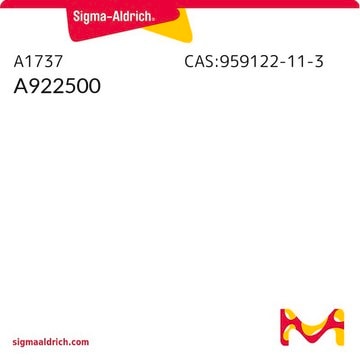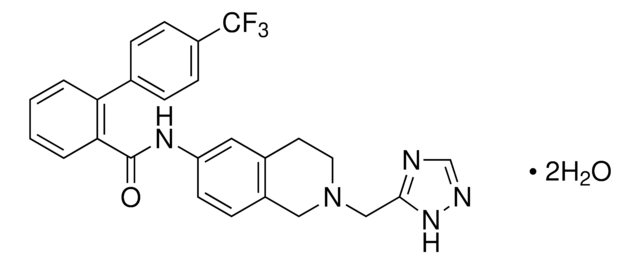SML0539
T863
≥98% (HPLC)
Sinónimos:
2-((1,4-trans)-4-(4-(4-Amino-7,7-dimethyl-7H-pyrimido[4,5-b][1,4]oxazin-6-yl)- phenyl)cyclohexyl)acetic acid, T-863, trans-4-[4-(4-Amino-7,7-dimethyl-7H-pyrimido[4,5-b][1,4]oxazin-6-yl)phenyl]-cyclohexaneacetic acid
About This Item
Productos recomendados
Análisis
≥98% (HPLC)
formulario
powder
color
white to beige
solubilidad
DMSO: 15 mg/mL (clear solution)
temp. de almacenamiento
2-8°C
cadena SMILES
CC1(C)Oc2ncnc(N)c2N=C1c3ccc(cc3)[C@@H]4CC[C@H](CC4)CC(O)=O
InChI
1S/C22H26N4O3/c1-22(2)19(26-18-20(23)24-12-25-21(18)29-22)16-9-7-15(8-10-16)14-5-3-13(4-6-14)11-17(27)28/h7-10,12-14H,3-6,11H2,1-2H3,(H,27,28)(H2,23,24,25)/t13-,14-
Clave InChI
FUIYMYNYUHVDPT-HDJSIYSDSA-N
Categorías relacionadas
Aplicación
- to provide the opportunity to precisely control the DGAT inhibition
- to treat mouse embryonic fibroblasts (MEFs) to analyse lipid droplet biogenesis
- to specifically block neutral lipid synthesis and lipid droplet formation in HT-1080 cells
- to block lipid droplet (LD) formation
Acciones bioquímicas o fisiológicas
Código de clase de almacenamiento
11 - Combustible Solids
Clase de riesgo para el agua (WGK)
WGK 3
Punto de inflamabilidad (°F)
Not applicable
Punto de inflamabilidad (°C)
Not applicable
Certificados de análisis (COA)
Busque Certificados de análisis (COA) introduciendo el número de lote del producto. Los números de lote se encuentran en la etiqueta del producto después de las palabras «Lot» o «Batch»
¿Ya tiene este producto?
Encuentre la documentación para los productos que ha comprado recientemente en la Biblioteca de documentos.
Nuestro equipo de científicos tiene experiencia en todas las áreas de investigación: Ciencias de la vida, Ciencia de los materiales, Síntesis química, Cromatografía, Analítica y muchas otras.
Póngase en contacto con el Servicio técnico








